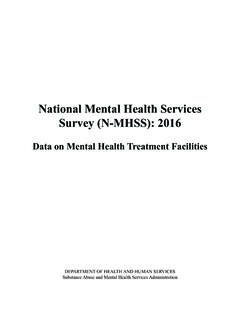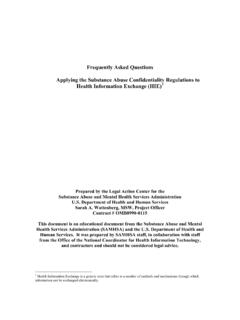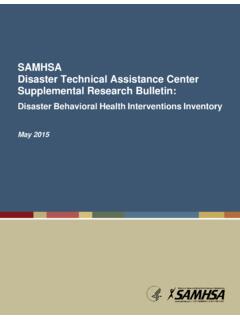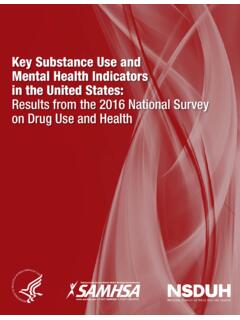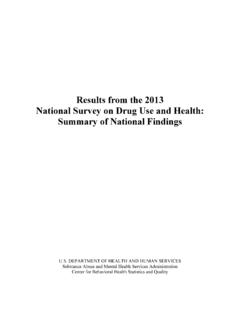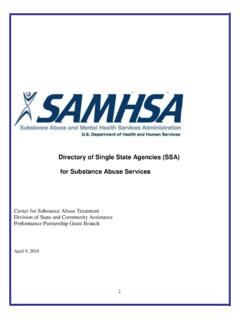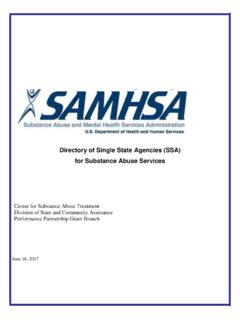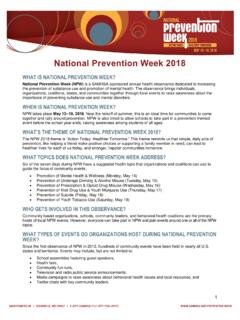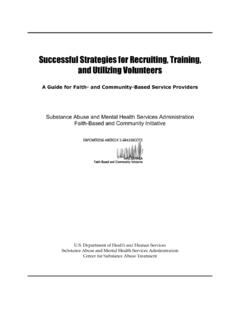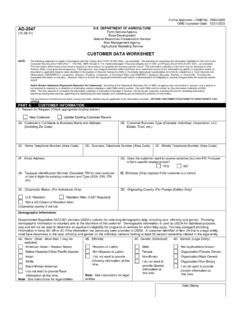Transcription of Racial/Ethnic Outatient Services Differences in Treatment
1 CHAPTER 1 IntroductionRacial/Ethnic Differences in mental health Service Use among AdultsRacePrevalenceTreatmentAdultsMenta l HealthMental health CareEthnicityOutpatient ServicesInpatient ServicesServicesiiSubstance Abuse and mental health Services Administration National Survey on Drug Use and HealthAcknowledgmentsThis chartbook was prepared by the Center for Behavioral health Statistics and Quality (CBHSQ), Substance Abuse and mental health Services Administration (SAMHSA), Department of health and Human Services (HHS), the National Institute of mental health (NIMH), National Institutes of health (NIH), and RTI International (a registered trademark and a trade name of Research Triangle Institute), Research Triangle Park, North Carolina. Work by RTI was performed under Contract No.
2 HHSS283201000003C and Task Order No. HHSS283200700002 Domain NoticeAll material appearing in this publication is in the public domain and may be reproduced or copied without permission from SAMHSA. However, this publication may not be reproduced or distributed for a fee without the specific, written authorization of the Office of Communications, SAMHSA, HHS. When using estimates and quotations from this publication, citation of the source is CitationSubstance Abuse and mental health Services Administration, Racial/Ethnic Differences in mental health Service Use among Adults. HHS Publication No. SMA-15-4906. Rockville, MD: Substance Abuse and mental health Services Administration, Access and Copies of PublicationThis publication may be downloaded from OfficeSubstance Abuse and mental health Services Administration Center for Behavioral health Statistics and Quality 1 Choke Cherry Road, Room 2-1067 Rockville.
3 MD 20857 February 2015 Contentsiiiy on Drug Use and HealthevNational Sur tiondministraes Avicerealth Stal Henbuse and Me ASubstancHighlights 11 Introduction 32 Methods 52 1 data Sources 52 2 Chartbook Methodology 6 Sample 6 Measures 7 Analyses 93 Racial/Ethnic Differences in mental health Service Use among Adults 113 1 Introduction 113 2 Racial/Ethnic Differences in Past Year mental health Service Utilization among Adults 123 3 Racial/Ethnic Differences in Reasons for Not Using mental health Services among Adults Who Reported an Unmet Need for Services
4 183 4 Summary 194 Differences in mental health Service Use among Adults with Any mental Illness 214 1 Introduction 214 2 Racial/Ethnic Differences in Past Year mental health Service Use among Adults with Any mental Illness 234 3 Racial/Ethnic Differences in Reasons for Not Using mental health Services among Adults with Any mental Illness Who Reported an Unmet Need for Services 284 4 Summary 295 Differences in mental health Service Use among Adults with Serious mental Illness 315 1 Introduction 315 2 Racial/Ethnic Differences in Past Year mental health Service Use among Adults with Serious mental Illness 335 3 Racial/Ethnic Differences in Reasons for Not Using mental health Services among Adults with Serious mental Illness Who Reported an Unmet Need for Services 385 4 Summary 39 End Notes
5 41 List of Figures 43 List of Tables 44 Contents (continued)ivSubstance Abuse and mental health Services Administration National Survey on Drug Use and HealthAppendixA mental health Service Use among Adults: Detailed Tables A-1B mental health Service Use among Adults with Any mental Illness: Detailed Tables B-1C mental health Service Use among Adults with Serious mental Illness: Detailed Tables C-1D List of Contributors D-1 Highlights1 This chartbook uses combined 2008 to 2012 data from the National Survey on Drug Use and health (NSDUH) to present nationally representative estimates of mental health service utilization among adults aged 18 or older within different Racial/Ethnic groups in the United States.
6 The percentages are annual averages. The highest estimates of past year mental health service use were for adults reporting two or more races ( percent), white adults ( percent), and American Indian or Alaska Native adults ( percent), followed by black ( percent), Hispanic ( percent), and Asian ( percent) adults. Estimates of prescription psychiatric medication use in the past year were highest for white adults ( percent), adults reporting two or more races ( percent), and American Indian or Alaska Native adults ( percent), followed by black ( percent), Hispanic ( percent), and Asian ( percent) adults. Outpatient mental health service use in the past year was highest for adults reporting two or more races ( percent), white adults ( percent), and American Indian or Alaska Native adults ( percent), followed by black ( percent), Hispanic ( percent), and Asian ( percent) adults.
7 Past year inpatient mental health service use was more prevalent among black adults ( percent) than white adults ( percent). Racial/Ethnic Differences in the estimates of any past year mental health service use were similar among all adults, adults with any mental illness (AMI), and adults with serious mental illness (SMI). Estimates of past year mental health service use increased with the severity of mental illness across all Racial/Ethnic groups. Few Racial/Ethnic Differences were found among the reasons for not using mental health Services among all adults, adults with AMI, and adults with SMI. Service cost or lack of insurance coverage was the most frequently cited reason for not using mental health Services across all Racial/Ethnic groups. The belief that use of mental health Services would not help was the least frequently cited reason for not using mental health Services across all Racial/Ethnic groups.
8 Among all adults and adults with AMI or SMI, white adults were generally the most likely to cite cost or insurance and believing that Services would not help as reasons for not using mental health Services compared with other Racial/Ethnic page intentionally left blank21 Introduction3 Substance Abuse and mental health Services Administration National Survey on Drug Use and HealthCHAPTER 1 IntroductionIn 2001, the Surgeon General released a seminal report, mental health : Culture, Race, and Ethnicity, that documented substantial Differences in mental health service utilization between non-Hispanic white adults and other Racial/Ethnic The report also noted Racial/Ethnic Differences in the types of Services that are used. Moreover, the Surgeon General determined that not all Differences in mental health service utilization resulted from personal preference.
9 Rather, many of the Racial/Ethnic Differences in mental health service utilization resulted from structural barriers, such as lack of transportation, low availability of care providers, cost, and insurance the same time, the Surgeon General identified an acute need for additional information on Racial/Ethnic Differences in mental health care delivery, as well as ongoing national surveillance of mental health service Currently, most national estimates of mental health service use among Racial/Ethnic groups are based on data nearing or more than a decade ,2,3,4,5,6,7,8,9,10,11 Since the release of the Surgeon General s report, significant policy changes have occurred, such as the mental health Parity and Addiction Equity Act of These policy changes have affected insurance coverage for mental health care and access to Moreover, with the passage of the Affordable Care Act of 2010,14 further changes in access to care are Abuse and mental health Services Administration National Survey on Drug Use and HealthCHAPTER 1 IntroductionThe purpose of this chartbook is to provide more recent, nationally representative estimates of mental health service utilization among adults aged 18 or older across different Racial/Ethnic groups in the United States.
10 These data may serve as a benchmark for examining future national-level changes in mental health service utilization among adults in different Racial/Ethnic groups in the United States, particularly in the context of relevant policy chartbook uses combined 2008 to 2012 data from the National Survey on Drug Use and health (NSDUH). NSDUH is the primary source of statistical information on the use of illegal drugs, alcohol, and tobacco by the civilian, noninstitutionalized population of the United States aged 12 years old or older. The survey also includes several modules of questions that focus on mental health issues. Conducted by the Federal Government since 1971, the survey collects data through face-to-face interviews with a representative sample of the population at the respondent s place of residence.
